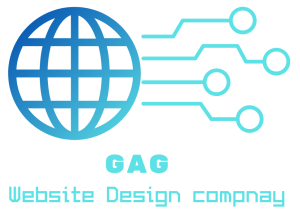In an era defined by rapid technological advancements, The Future of Website Design is continuously evolving. From user experience enhancements to the integration of cutting-edge technologies, the future holds countless possibilities. This article explores the predictions and trends shaping the future of website design, offering insights into the innovative strategies and approaches that will define the digital experiences of tomorrow. Join us as we delve into the exciting realm of web design and discover what lies ahead.
Evolution of User Experience (UX)

User experience (UX) lies at the heart of effective website design, shaping how users interact with and perceive digital platforms. Understanding the evolution of UX provides valuable insights into current trends and future directions in web design.
Past trends and present state: Historically, UX design has transitioned from simple, static web pages to dynamic, interactive experiences. Early websites focused primarily on delivering information, often with limited consideration for user engagement or satisfaction. However, as technology advanced and user expectations evolved, designers began prioritizing intuitive navigation, visually appealing layouts, and seamless interactions.
Today, UX encompasses a multifaceted approach that considers not only usability but also emotional and psychological factors. Websites are designed to evoke specific emotions, establish brand identities, and foster meaningful connections with users. Elements such as responsive design, intuitive navigation menus, and interactive features have become standard practices, reflecting the growing importance of user-centric design principles.
Anticipated shifts in UX design: Looking ahead, several key shifts are expected to shape the future of UX design. One significant trend is the increasing integration of artificial intelligence (AI) and machine learning algorithms. These technologies enable personalized user experiences by analyzing data and predicting user preferences. From tailored product recommendations to adaptive interfaces, AI-driven UX design has the potential to revolutionize how websites engage with their audiences.
Additionally, the rise of augmented reality (AR) and virtual reality (VR) presents new opportunities for immersive user experiences. AR and VR technologies can transport users to virtual environments, allowing for interactive product demonstrations, virtual tours, and enhanced storytelling capabilities. As these technologies become more accessible and widespread, they are likely to play a significant role in shaping the future of web design.
Incorporating user feedback and behavior analysis: Furthermore, the future of UX design will rely heavily on continuous user feedback and behavior analysis. By collecting and analyzing user data, designers can gain valuable insights into user preferences, pain points, and behaviors. This data-driven approach enables iterative improvements and optimizations, ensuring that websites remain relevant and engaging in an ever-changing digital landscape.
Emerging Technologies Shaping Web Design
The future of website design is intricately tied to the adoption and integration of emerging technologies. From artificial intelligence (AI) to augmented reality (AR), these innovations are poised to revolutionize the way we create and interact with digital experiences.
AI integration in design processes: Artificial intelligence is rapidly transforming various aspects of web design, offering new tools and capabilities to designers. AI-powered design platforms can automate repetitive tasks, such as generating layouts, selecting color schemes, and optimizing content for different devices. Machine learning algorithms analyze user behavior and preferences, allowing for personalized recommendations and dynamic content delivery. By harnessing the power of AI, designers can streamline their workflows, improve efficiency, and create more engaging user experiences.
Augmented Reality (AR) and Virtual Reality (VR) in web interfaces: The integration of augmented reality (AR) and virtual reality (VR) technologies opens up exciting possibilities for immersive web experiences. AR overlays digital content onto the real world, enabling interactive product demonstrations, virtual try-on experiences, and enhanced storytelling. VR, on the other hand, transports users to virtual environments, creating fully immersive simulations and interactive narratives. As AR and VR technologies become more accessible and user-friendly, they are poised to transform the way we engage with websites, blurring the lines between the digital and physical worlds.
Impact of Internet of Things (IoT) on web experiences: The Internet of Things (IoT) is another technology reshaping web design by connecting everyday objects to the internet and enabling communication between devices. Smart devices, such as wearables, home appliances, and connected cars, generate vast amounts of data that can be leveraged to create personalized web experiences. For example, a fitness tracker could sync with a health and wellness website to provide personalized workout recommendations based on the user’s activity level and fitness goals. By integrating IoT devices with web interfaces, designers can create seamless, context-aware experiences that anticipate and fulfill user needs.
Responsive and Adaptive Design
In an increasingly mobile-centric world, responsive and adaptive design principles have become paramount in ensuring optimal user experiences across devices of all sizes. This section explores the importance of responsive and adaptive design, as well as strategies for implementation and optimization.
Importance of mobile optimization: With the proliferation of smartphones and tablets, more users are accessing websites on mobile devices than ever before. Therefore, optimizing websites for mobile is no longer a luxury but a necessity. Mobile-optimized websites load quickly, are easy to navigate, and provide seamless interactions, enhancing user satisfaction and retention. Moreover, search engines prioritize mobile-friendly websites in their rankings, making mobile optimization crucial for maintaining visibility and driving organic traffic.
Implementing responsive and adaptive design principles: Responsive design involves creating websites that automatically adjust their layout and content based on the user’s screen size and orientation. This ensures a consistent and optimal viewing experience across devices, from desktop computers to smartphones. Adaptive design, on the other hand, involves creating multiple versions of a website, each optimized for specific screen sizes or device types. Adaptive design allows for more granular control over the user experience but requires additional resources and maintenance.
Designers can implement responsive and adaptive design principles using a variety of techniques, such as fluid grids, flexible images, and media queries. These techniques enable websites to adapt seamlessly to different screen sizes and resolutions, ensuring that users receive a visually appealing and functional experience regardless of the device they’re using.
Strategies for cross-device compatibility: Cross-device compatibility is essential for ensuring that websites perform consistently across a wide range of devices and platforms. Designers can achieve cross-device compatibility by thoroughly testing websites on various devices and browsers, identifying and addressing any issues or inconsistencies. Additionally, adopting a mobile-first approach, where the mobile experience is prioritized during the design process, can help ensure that websites are optimized for smaller screens and touch interactions from the outset.
Personalization and Dynamic Content

The demand for personalized web experiences continues to grow as users expect tailored content and interactions that cater to their individual preferences and needs. This section explores the importance of personalization in web design, strategies for implementing dynamic content, and considerations for balancing customization with privacy concerns.
Customization trends in web design: Personalization has become a key trend in web design, driven by advancements in data analytics, machine learning, and user segmentation techniques. Users expect websites to deliver content and recommendations that align with their interests, browsing history, and demographic profiles. By personalizing the user experience, websites can enhance engagement, increase conversions, and build stronger connections with their audience.
Dynamic content delivery based on user preferences: Dynamic content delivery involves tailoring website content and interactions in real-time based on user behavior, preferences, and contextual factors. For example, an e-commerce website might display personalized product recommendations based on the user’s past purchases or browsing history. Similarly, a news website might prioritize content topics that align with the user’s interests or geographic location. By delivering relevant and timely content, websites can capture users’ attention and encourage deeper engagement.
Balancing personalization with privacy concerns: While personalization offers significant benefits, it also raises privacy concerns related to data collection, tracking, and targeting. Users are increasingly wary of sharing their personal information online and may be hesitant to engage with websites that prioritize personalization at the expense of privacy. Therefore, it’s essential for designers to strike a balance between personalization and privacy by implementing transparent data practices, obtaining user consent for data collection, and respecting user preferences regarding data usage and tracking.
Accessibility and Inclusivity
Ensuring that websites are accessible to users of all abilities is not only a legal requirement in many regions but also a fundamental aspect of ethical web design. This section explores the importance of accessibility and inclusivity in web design, strategies for designing accessible websites, and challenges in achieving inclusivity.
Designing for diverse user needs: Accessibility in web design involves creating websites that can be easily navigated and understood by users with disabilities, including visual, auditory, motor, and cognitive impairments. Designing for accessibility benefits not only users with disabilities but also older adults, users with temporary impairments (such as a broken arm), and users in challenging environments (such as bright sunlight or noisy surroundings). By considering a diverse range of user needs and abilities, designers can create more inclusive and user-friendly web experiences for everyone.
Ensuring web accessibility standards compliance: Web accessibility standards, such as the Web Content Accessibility Guidelines (WCAG), provide a framework for designing and evaluating accessible websites. These standards cover a wide range of accessibility requirements, including text alternatives for non-text content, keyboard navigation support, color contrast ratios, and semantic markup for screen readers. Designers can ensure compliance with accessibility standards by following best practices, conducting accessibility audits and testing, and using accessibility tools and plugins during the design and development process.
Addressing challenges of inclusivity in design: While accessibility guidelines provide valuable guidance for designing accessible websites, achieving true inclusivity in web design requires addressing broader societal barriers and biases. Designers must consider factors such as language diversity, cultural differences, and socioeconomic disparities when designing web experiences. Additionally, inclusivity involves challenging stereotypes and biases in design, such as assumptions about user abilities, preferences, and needs. By adopting a human-centered approach to design and involving diverse stakeholders in the design process, designers can create more inclusive and equitable web experiences for all users.
Minimalism and Visual Storytelling

In a digital landscape characterized by information overload, minimalism and visual storytelling have emerged as powerful design strategies for capturing users’ attention and conveying compelling narratives. This section explores the trends towards minimalistic design aesthetics, the utilization of visual storytelling techniques, and the balance between simplicity and engagement in web design.
Trends towards minimalistic design aesthetics: Minimalism in web design involves stripping away unnecessary elements and focusing on simplicity, clarity, and functionality. Minimalistic design aesthetics prioritize clean layouts, generous white space, and minimalist typography to create elegant and uncluttered web experiences. By reducing visual noise and distractions, minimalistic design allows users to focus on the essential content and tasks, enhancing usability and readability.
Utilizing visual storytelling techniques: Visual storytelling is a powerful tool for engaging users and conveying complex ideas and emotions through imagery, typography, and interactive elements. By combining visual elements with narrative techniques, designers can create immersive and memorable web experiences that resonate with users on an emotional level. Visual storytelling can take many forms, including interactive animations, parallax scrolling effects, and multimedia presentations. These techniques help bring content to life, evoke emotional responses, and guide users through a cohesive narrative journey.
Balancing simplicity with engagement: While minimalism emphasizes simplicity and clarity, it’s essential to strike a balance between simplicity and engagement in web design. Designers must ensure that minimalist designs are not overly sterile or devoid of personality, as this can lead to bland and forgettable user experiences. Instead, designers should focus on creating visually striking designs that capture users’ attention while maintaining a sense of elegance and sophistication. By carefully selecting and arranging visual elements, designers can create minimalist designs that are both aesthetically pleasing and engaging.
The Future of Website Design Conclusion
In the ever-evolving landscape of website design, the future is filled with exciting possibilities.
From the integration of emerging technologies like artificial intelligence and augmented reality to the prioritization of accessibility and inclusivity, designers are constantly pushing the boundaries of creativity and innovation.
By embracing trends towards minimalism and visual storytelling, designers can create engaging and memorable web experiences that captivate users’ attention and convey compelling narratives.
However, amidst this pursuit of innovation, it’s crucial to remain mindful of ethical considerations, such as privacy, inclusivity, and accessibility.
By designing with empathy and inclusivity in mind, designers can ensure that the digital experiences of tomorrow are not only aesthetically pleasing but also equitable, accessible, and meaningful for users of all abilities and backgrounds.
As we look towards the future of website design, one thing is certain: the possibilities are endless, and the journey of innovation is just beginning.
FAQs (Frequently Asked Questions) The Future of Website Design
- Why is user experience (UX) design important in website development?
- User experience design is crucial in website development as it focuses on creating interfaces that are intuitive, easy to use, and enjoyable for users. A positive user experience leads to increased engagement, higher conversion rates, and improved brand perception.
- How can websites incorporate emerging technologies like AI and AR?
- Websites can incorporate emerging technologies like artificial intelligence (AI) by implementing personalized recommendations, chatbots for customer support, and content optimization algorithms. Augmented reality (AR) can be integrated into websites to offer interactive product demonstrations, virtual try-on experiences, and immersive storytelling.
- What are the benefits of responsive and adaptive design?
- Responsive and adaptive design ensures that websites display optimally across devices of all sizes, from desktop computers to smartphones and tablets. Benefits include improved user experience, higher search engine rankings, and increased accessibility for users on different devices.
- How can websites personalize content while respecting user privacy?
- Websites can personalize content by analyzing user data and preferences while respecting user privacy through transparent data practices, obtaining user consent for data collection, and providing options for users to control their privacy settings.
- What are the key principles of accessible web design?
- Accessible web design follows principles outlined in standards such as the Web Content Accessibility Guidelines (WCAG), which include providing text alternatives for non-text content, ensuring keyboard accessibility, and maintaining color contrast ratios for readability.
- How can designers balance minimalism with engaging design aesthetics?
- Designers can balance minimalism with engaging design aesthetics by focusing on clean layouts, clear navigation, and visually striking elements that capture users’ attention while maintaining simplicity and clarity in design.
- What role does visual storytelling play in The Future of Website Design ?
- Visual storytelling enhances web design by conveying narratives and emotions through imagery, typography, and interactive elements. It creates immersive experiences that resonate with users and guide them through a cohesive narrative journey.
- How can designers ensure inclusivity in The Future of Website Design ?
- Designers can ensure inclusivity in web design by considering diverse user needs and abilities, following accessibility standards, and challenging biases and stereotypes in design to create equitable and accessible experiences for all users.



